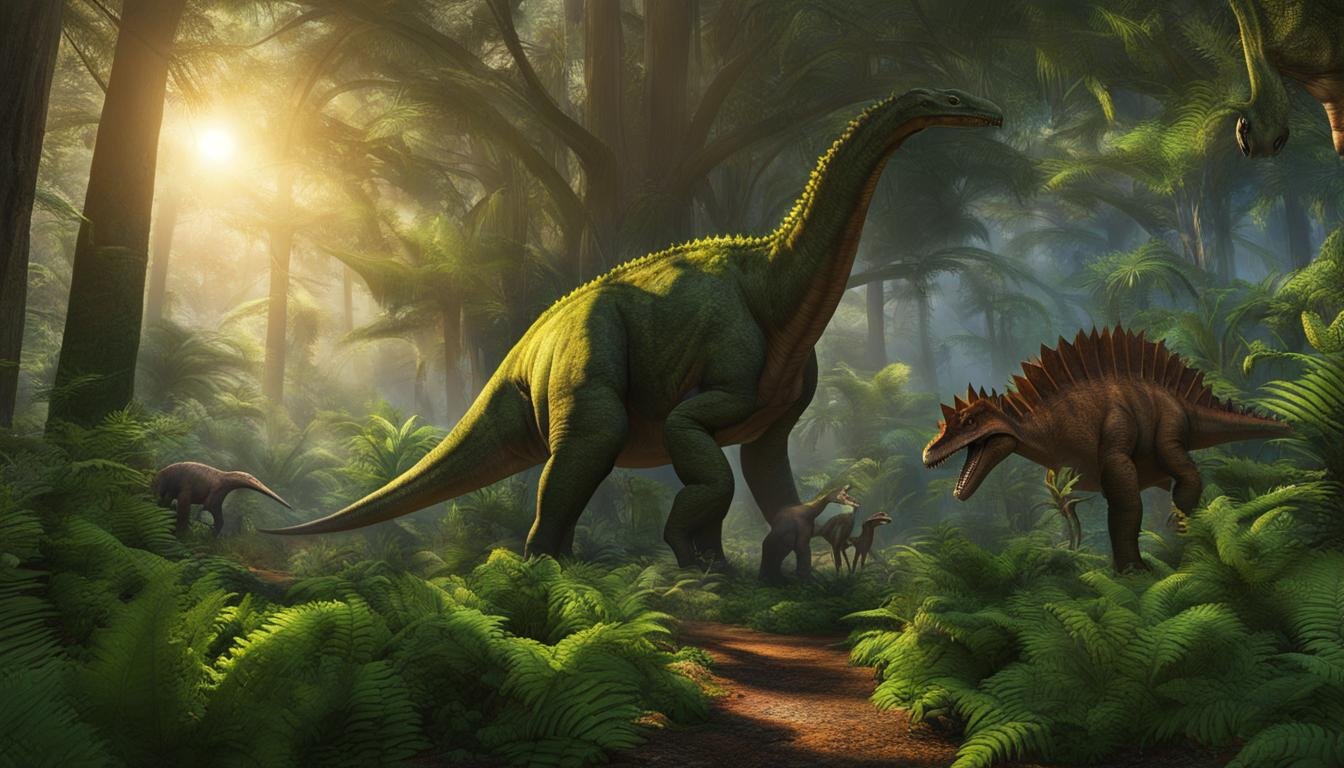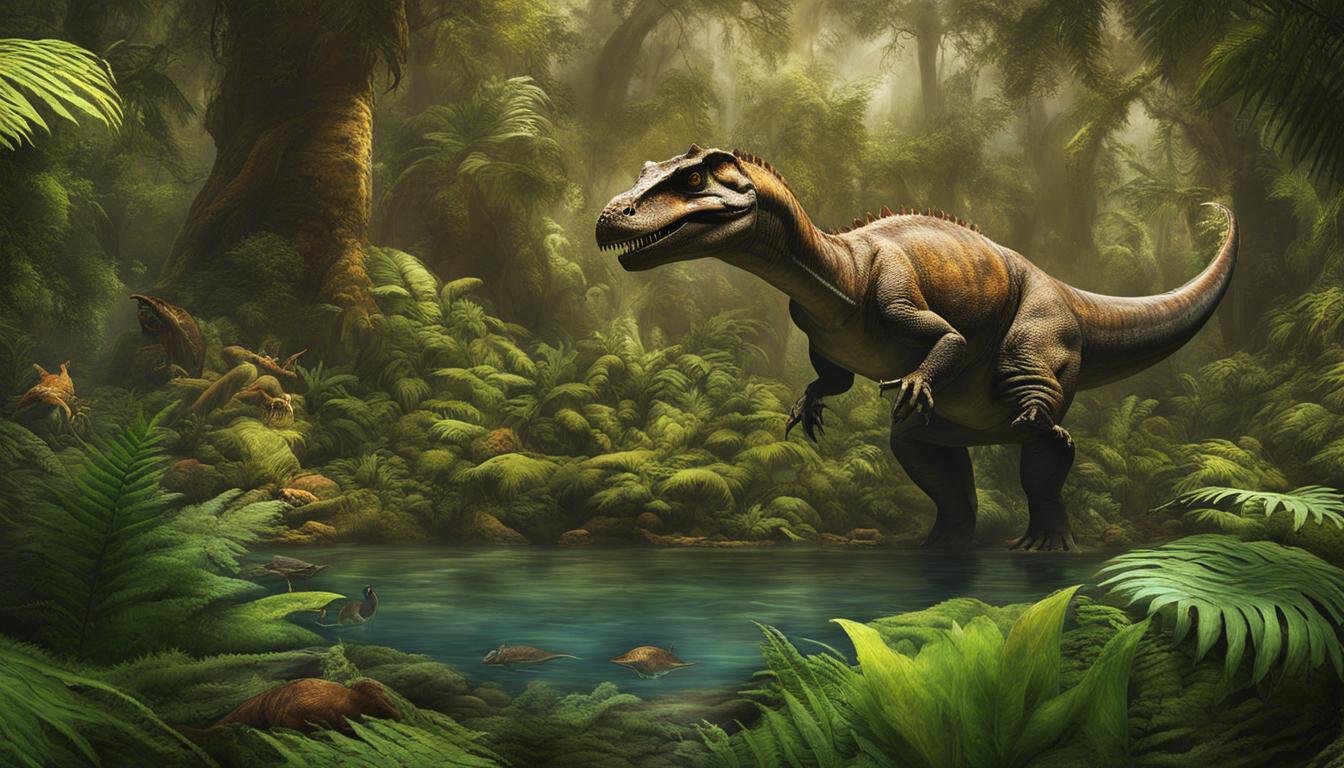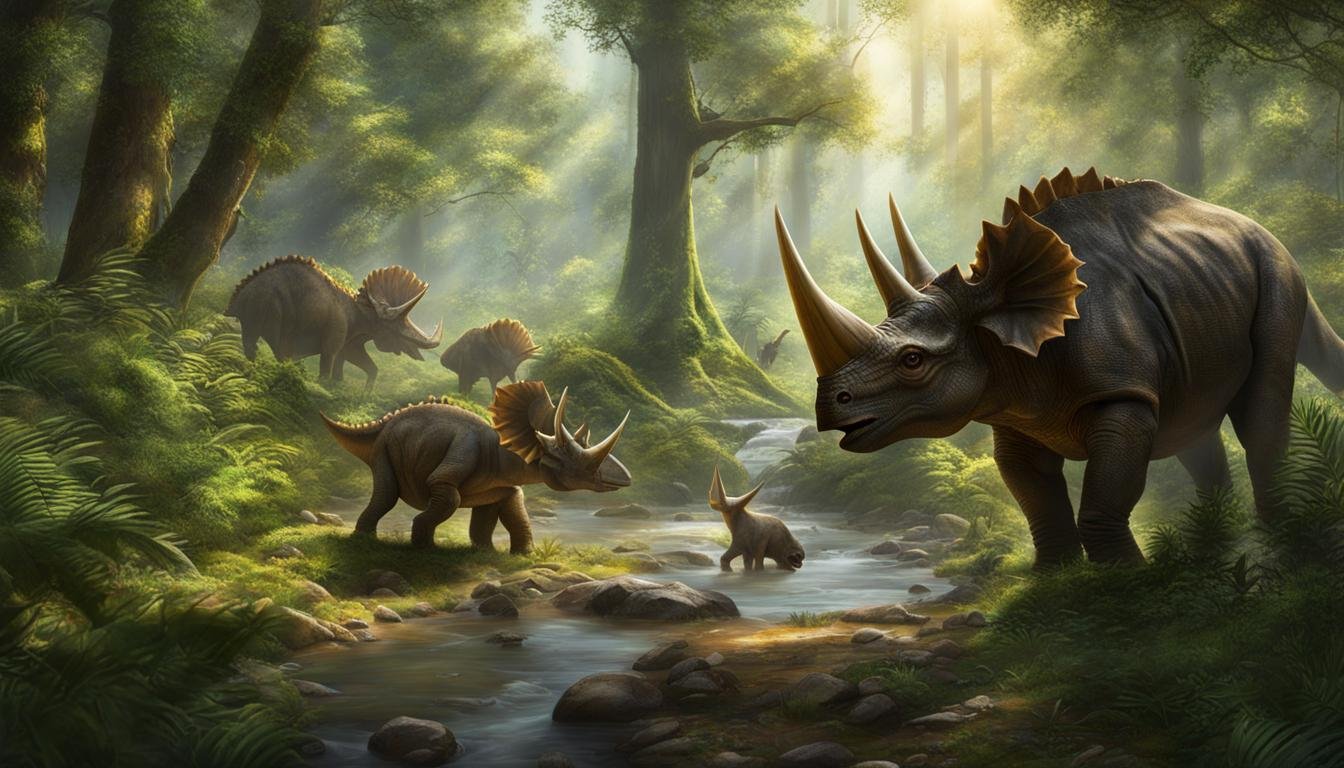Welcome to the fascinating world of paleoecology! This interdisciplinary field focuses on reconstructing past ecosystems using geological and biological evidence. Through the study of ancient organisms, populations, communities, landscapes, environments, and ecosystems, paleoecologists provide valuable insights into Earth’s history and the processes that have shaped our planet.
Paleoecological research involves analyzing fossils, sediment records, and other proxies to gain a deeper understanding of the composition and dynamics of past ecosystems. By piecing together these clues, researchers can unravel the intricate tapestry of ancient life and the environmental conditions in which it thrived.
From the rich biodiversity of ancient forests to the intricate interactions between species in long-lost communities, paleoecology offers a window into Earth’s past that helps us comprehend ecological processes, environmental changes, and the evolution of species.
| Key Takeaways | Description |
|---|---|
| Definition of Paleoecology | Paleoecology involves studying ancient ecosystems through geological and biological evidence. |
| Methods of Reconstruction | Paleoecologists use fossils, sediment records, and various proxies to reconstruct past environments and understand ecological dynamics. |
| Contributions to Earth’s History | The field provides critical information about the Earth’s history and the evolution of life on our planet. |
| Influence on Modern Conservation | Insights from paleoecology are crucial for informing contemporary conservation and ecosystem management strategies. |
Understanding Past Environments through Paleoecological Reconstruction
Paleoenvironmental reconstruction is a fundamental aspect of paleoecology, as it allows researchers to gain insights into the ancient ecosystems that once existed. By piecing together clues from various sources such as sediment types, taphonomic factors, climate data, and the organisms themselves, paleoecologists can better understand the past environment. These clues provide valuable information about abiotic factors like temperature, water depth, precipitation, and water salinity, as well as the interactions between different species in fossil assemblages.
The process of paleoenvironmental reconstruction involves analyzing the fossil record found in sediments. Fossils can reveal important details about past organisms and their ecological roles, helping researchers understand the composition and dynamics of ancient ecosystems. Additionally, taphonomic factors, such as how the fossils were preserved, provide insights into the conditions under which these organisms lived.
Climate data is another crucial component of paleoenvironmental reconstruction. By examining climate proxies like oxygen isotopes in sediment cores or tree ring patterns, paleoecologists can infer past climate conditions. These proxies act as indicators, providing information about temperature, precipitation, and other climatic variables. By combining all these pieces of evidence, paleoecologists can create a comprehensive picture of the past environment and the organisms that inhabited it.
Through the use of a wide range of proxies and analytical techniques, paleoecologists can unlock the secrets of ancient ecosystems and gain a deeper understanding of Earth’s history. By reconstructing past environments, they contribute to our knowledge of how ecosystems have evolved over time and provide valuable insights into the factors that shape the natural world.
The Importance of Paleoecological Reconstruction
Paleoecological reconstruction is essential for several reasons. Firstly, it allows scientists to study the impacts of past environmental changes on ecosystems and species. By understanding how organisms have responded to environmental shifts in the past, researchers can gain insights into how species might adapt or be affected by future changes.
Furthermore, paleoecology can provide valuable information for conservation and restoration efforts. By studying pre-industrial ecosystems, paleoecologists can identify the native species and ecological processes that once existed in a particular area. This knowledge can inform restoration projects and help guide conservation efforts towards a more sustainable future.
In summary, paleoecology plays a pivotal role in reconstructing past environments and understanding the dynamics of ancient ecosystems. Through the use of proxies, such as the fossil record and climate data, paleoecologists can gain valuable insights into the abiotic and biotic factors that shaped these ecosystems. This knowledge not only enhances our understanding of Earth’s history but also informs conservation and management efforts to protect present-day ecosystems.
Proxies for Reconstructing Past Environments
Proxies play a vital role in paleoecology by providing indirect measurements or indicators that offer insights into past environments. Just like observing palm trees suggests a warm environment and polar bears indicate a cold environment in the present day, paleoecologists use similar proxies to infer past climates. Tree rings, for example, serve as a valuable proxy for past climate conditions, revealing information about temperature and precipitation patterns over time. Similarly, ice cores provide high-resolution records of past climate change by analyzing layers of ice and the particles trapped within them.
Tree rings, also known as dendrochronology, offer a unique window into the past. Each tree ring represents a year of growth, and the width and characteristics of the rings can indicate fluctuations in temperature and moisture levels. By analyzing tree rings from living trees and correlating them with modern climate data, paleoecologists are able to reconstruct historical climate conditions with a remarkable level of accuracy.
Ice cores, on the other hand, provide a glimpse into the distant past. These cylindrical samples of ice extracted from glaciers and ice sheets can provide information about temperature, atmospheric composition, and even volcanic eruptions that occurred thousands of years ago. By analyzing the composition of gases trapped in the ice, such as carbon dioxide and methane, scientists can reconstruct past greenhouse gas concentrations and gain insights into natural climate cycles.
The Usefulness of Proxies in Paleoecology
Proxies are invaluable tools for paleoecologists, allowing them to reconstruct past environments and gain a deeper understanding of the Earth’s history. Through the analysis of tree rings and ice cores, researchers can decipher climate trends, identify the drivers of environmental change, and explore the interactions between organisms and their surroundings. These insights not only contribute to our knowledge of ancient ecosystems but also provide valuable context for understanding and predicting future environmental changes.
Proxies such as tree rings and ice cores are just a few examples of the diverse range of tools and indicators used in paleoecology. By combining different proxies and studying multiple lines of evidence, paleoecologists can create a comprehensive picture of past environments and ecosystems. This multidisciplinary approach helps to unlock the secrets of Earth’s past and provides crucial insights into how our planet has evolved over time.
| Proxy | Application |
|---|---|
| Tree Rings (Dendrochronology) | Reconstructing past temperature and precipitation patterns |
| Ice Cores | Examining past greenhouse gas concentrations and climate change |
| Sediment Cores | Investigating past marine and freshwater environments |
| Fossil Pollen | Exploring past vegetation and plant communities |
| Oxygen Isotopes | Studying past temperature and climate dynamics |
Insights from Dendrochronology and Ice Core Analysis
One of the key tools used in paleoecology to understand past climate conditions is dendrochronology, the study of tree rings. Tree rings provide valuable information about past temperature and precipitation patterns. By analyzing the width and composition of tree rings, dendrochronologists can infer climatic variations over time. The width of tree rings, for example, is influenced by the availability of water and nutrients, which in turn is affected by temperature and precipitation. This allows researchers to reconstruct past climate conditions and identify periods of drought, rainfall, or temperature fluctuations.
“Dendrochronology has revolutionized our understanding of past climate variability by providing a precise record of annual climate conditions. It allows us to go back thousands of years and reconstruct climate patterns with remarkable accuracy” – Dr. Jane Thompson, Paleoclimatologist
Another important tool in paleoecology is the analysis of ice cores. Ice cores are cylinders of ice that are drilled from glaciers or ice sheets. Within these ice cores, researchers can analyze the composition of trapped air bubbles, isotopes, and other markers to reconstruct past climate conditions. This provides a high-resolution record of past climate change, including the concentrations of greenhouse gases in the atmosphere over hundreds of thousands of years.
The analysis of ice cores has revealed important insights into the natural cycles of warming and cooling that have occurred in the past. For example, it has helped confirm the link between increased greenhouse gas concentrations and global warming. By studying ice cores, scientists can also gain a better understanding of the interactions between climate, ecosystems, and human societies throughout history.
| Insights from Dendrochronology and Ice Core Analysis | Dendrochronology | Ice Core Analysis |
|---|---|---|
| Climate Reconstruction | Provides precise records of past temperature and precipitation patterns | Reveals high-resolution records of past climate change and greenhouse gas concentrations |
| Drought and Rainfall Patterns | Helps identify periods of drought and rainfall fluctuations | Provides insights into long-term climate trends and natural cycles of warming and cooling |
| Environmental Interactions | Allows researchers to understand the relationships between climate, ecosystems, and human societies | Provides information about the impact of climate change on ecosystems and biodiversity |
By combining the insights gained from dendrochronology and ice core analysis, paleoecologists can paint a more comprehensive picture of past climates and ecosystems. These tools not only enhance our understanding of Earth’s history but also provide valuable information for predicting future climate change and making informed decisions about conservation and sustainability.
Contributions of Paleoecology to Understanding Past Ecosystems
Paleoecology, particularly Quaternary paleoecology and deep-time paleoecology, has played a significant role in unraveling the mysteries of ancient ecosystems. Through the reconstruction of past biota, populations, communities, landscapes, environments, and ecosystems, paleoecologists have provided valuable insights into the dynamics of these past ecosystems.

By understanding the paleoenvironment and applying ecological explanations, researchers have gained a clearer understanding of the factors that shaped biodiversity, community structure, and ecological systems. The information derived from paleoecological research helps us comprehend the relationships between organisms and their environment, providing a historical context for present-day ecological processes.
Paleoecology also serves as a crucial baseline for conservation, management, and restoration efforts. By examining pre-industrial species composition and disturbance regimes, researchers can better inform strategies to preserve and restore ecosystems to their natural states. This historical perspective highlights the impact of human activities and sheds light on the consequences of environmental changes over time.
Overall, paleoecology offers a unique window into the Earth’s past, enabling us to gain insights into extinct species, environmental changes, and the overall functioning of ancient ecosystems. With its interdisciplinary approach and reliance on paleoenvironmental reconstruction, paleoecology contributes invaluable knowledge to the scientific community and society as a whole.
Conclusion
Paleoecology, the study of ancient ecosystems, plays a crucial role in unraveling the mysteries of Earth’s past. By reconstructing these ancient ecosystems, paleoecologists provide valuable insights into the environmental changes that have occurred over time. Through their research, they help us understand the dynamics of extinct species and how they interacted with their surroundings.
Using proxies such as tree rings and ice cores, paleoecologists are able to reconstruct past environments and gain a deeper understanding of Earth’s history. By studying these ancient ecosystems, we can learn from the past and apply that knowledge to our present-day conservation efforts. The contributions of paleoecology enhance our understanding of the natural world and help inform strategies for managing our modern ecosystems.
By exploring Earth’s past through the lens of paleoecology, we gain a greater appreciation for the intricate web of life that has existed over millions of years. The insights provided by paleoecology not only shed light on the ancient ecosystems that have long since vanished but also contribute to our understanding of biodiversity, ecological systems, and the effects of environmental changes. It is through this knowledge that we can better protect and preserve the ecosystems we have today, creating a sustainable future for our planet.









